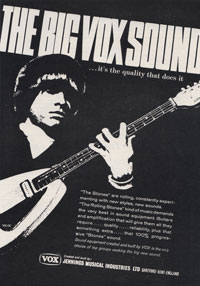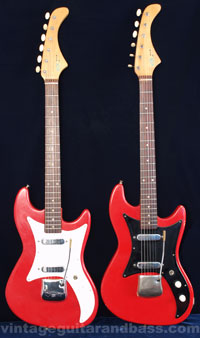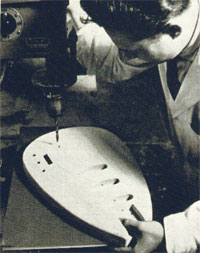

Vox was a massive name in 1960s Britain, with Vox guitars and even more Vox amplifiers widely used by the very biggest names in British music: The Beatles, The Rolling Stones, The Animals, The Hollies, The Dave Clark Five and the Yardbirds, to name but a few. Soon American acts would join the roster, most notably Paul Revere & the Raiders and James Brown, but also countless less well known bands. For a few short years in the mid 1960s, the Vox name was everywhere. Today, vintage Vintage Vox guitars are highly collectable, especially the teardrop and phantom styed guitars, and the more unusual models: early JMI guitars and those with complicated inbuilt effects circuitry.
But the story of the 1960s Vox guitars is complicated, with many different guitars made in different plants worldwide, often quite different from each other. But it started in England; JMI were making Vox guitars at a factory in Dartford, Kent (See pic), primarily for Shadows fans in the UK. After Beatlemania, Brian Jones' teardrop Mark VI and the British Invasion of 1964, they could not keep up with worldwide demand, especially in the US. JMI outsourced some production to two Italian factories, EKO in Recanati, and Crucianelli, primarily for the American market, and at it's peak had a huge number of models available. Eventually the UK factory ceased guitar production, and the last few Vox guitars available for several years, were the Vox Giant range guitars, made in Japan.
Today, many of these rare guitars are highly collectable, with vintage Vox guitar values on the rise. They are loved for their crazy shapes and for the exciting sounds from the built-in guitar effects. Have a listen to some vintage Vox soundclips.
Vox guitars have been produced by various manufacturers in the United Kingdom, Italy and Japan; for convenience, you can split 1960s Vox guitars into four main categories. Each had different components, and it is not too difficult to place a guitar in one of these groups, just by looking at controls, pickups etc.


The earliest UK Vox's were solid-body guitars, assembled in the JMI 'Unity Works' plant in Dartford, Kent, with components coming from numerous British suppliers. Later necks were imported from Italy, but even with an Italian neck, these are regarded as the British Voxs. Unable to cope with worldwide demand, a second plant 'West Street' was opened nearby in 1965, but was badly damaged by fire in January 1966. Numerous JMI guitars were produced in the UK, from the Fender-style solid bodies Shadow, Ace, Stroller and Consort, to more original designs, such as the Phantom, Mark and Marauder. These were primarily for the British market, though many were exported to the United States in the early/mid 1960s.
At the same time, there was significant demand for hollow-body instruments, something not easily produced in any numbers at the Dartford plant. So Vox imported a range of guitars from Italian manufacturer Crucianelli. These models include the Vox Lynx, Vox Cougar bass, Vox Challenger, and Escort bass. Furthermore, demand for solid body UK models was so high that certain guitars were produced simultaneously in Britain and Italy (primarily by Eko of Recanati). Italian Phantoms from this period have some differing components and construction from their British-built counterparts.
The third main phase of Vox production is possibly the best known worldwide. These were the Italian built Vox's from the EME factory in Recanati; a joint Venture between Vox UK, Eko in Italy, and Vox's US distributor Thomas Organ. Most of these instruments were bound for the United States, where they were distributed by the Thomas Organ Company.
Although they have distinctive components, and often built-in electronic effects, most were versions of existing Vox models: primarily the phantom and teardrop shaped guitars (eg Delta, Starstream), Gibson/Gretsch-style single and double cutaway hollow bodies, (Ultrasonic, Viper, Cheetah, Apollo, Bossman) - plus the Invader and Thunderjet solid bodies.
From 1966 things started going wrong for Vox, ultimately resulting in the company briefly going out of business, and Vox guitar manufacture ending in the UK. By mid 1968, JMI were in the hands of the receiver. Leftover Vox guitars were distributed unbranded (though potentially still with some Vox markings) by Dallas Arbiter.
The last Vox's produced in the 1960s, (and into the early 70s) were the Japanese-made Vox Giant guitars. Aimed at the UK/European market, and first shown at the August 1968 Frankfurt trade fair. These guitars were mainly copies of American designs - Les Paul (and later SG) styled solid bodies and Gretsch Country Gent styled semi acoustics - quite nice guitars, but without the uniqueness of earlier models. These did not sell particularly well, and importation quickly stopped, leaving Vox to concentrate on Amplifiers for the rest of the 1970s.
Unfortunately dating Vox guitars by serial number is hard. There is no Vox guitar serial number lookup. Records of JMI guitar production does not exist at all, whilst EME Vox serial number data does exist, but is not widely available. However serial numbers were applied more or less consecutively, and by examining certain features of guitars it is possible to suggest an approximate shipping date. UK built Vox guitars are often equipped with datable components (e.g. Morganite and Egen potentiometers - see potentiometer codes which gives an approximate date of manufacture.
The most recent content posted to this site on vintage Vox guitars:
 The Vox Super Ace was a mid-priced British solid body electric guitar, produced by JMI at their factory in Dartford, Kent. It was broadly modelled on the Fender Stratocaster, and a sibling model to the dual-pickup Vox Ace. Both the Ace, and Super Ace (along with several other models), were redesigned in 1963 with a new body shape, headstock style, and pickup layout - only increasing the resemblance to the aforementioned Fender. The Super Ace had a 1963 price tag of £47 5S. It's a pretty nice playing guitar with some lovely sounds - check out the videos on this page, and in the Vintage Guitar and Bass supporting members area
The Vox Super Ace was a mid-priced British solid body electric guitar, produced by JMI at their factory in Dartford, Kent. It was broadly modelled on the Fender Stratocaster, and a sibling model to the dual-pickup Vox Ace. Both the Ace, and Super Ace (along with several other models), were redesigned in 1963 with a new body shape, headstock style, and pickup layout - only increasing the resemblance to the aforementioned Fender. The Super Ace had a 1963 price tag of £47 5S. It's a pretty nice playing guitar with some lovely sounds - check out the videos on this page, and in the Vintage Guitar and Bass supporting members area
 The Vox New Escort was Vox's version of the Fender Telecaster, at a time when American guitars were out of reach for most British musicians. It was made by JMI in England, for the British market, and unlike the majority of other models, didn't have an Italian-made equivalent. But the New Escort wasn't a slavish Fender copy, adding Vox's stylish teardrop headstock to the tele-style body, with a stop tailpiece and two Vox V2 single coil pickups. And it's a pretty substantial, and nice playing guitar, with a very comfortable neck. Check out the images, specifications, and watch a video of it in action. There is also extra content in the vintageguitarandbass supporting members area.
The Vox New Escort was Vox's version of the Fender Telecaster, at a time when American guitars were out of reach for most British musicians. It was made by JMI in England, for the British market, and unlike the majority of other models, didn't have an Italian-made equivalent. But the New Escort wasn't a slavish Fender copy, adding Vox's stylish teardrop headstock to the tele-style body, with a stop tailpiece and two Vox V2 single coil pickups. And it's a pretty substantial, and nice playing guitar, with a very comfortable neck. Check out the images, specifications, and watch a video of it in action. There is also extra content in the vintageguitarandbass supporting members area.
 The Symphonic bass was built in the UK, by Vox parent company JMI. It was the Vox equivalent to the Fender Precision bass, and was one of the most expensive Vox guitars produced. It was actually a great playing bass, rather similar to the Precision in feel and sound, but was probably just too expensive compared to an actual Fender and consequently sold poorly. When Vox hit financial problems in 1968, unsold guitars and basses were passed on to Dallas Arbiter, who briefly sold the excess Symphonic bass stock as model 4537. This bass, although with a neck date of February 1966, was most likely one of the unsold Vox guitars sold on by Dallas Arbiter. Check out the bass, and the two video demos through 1960s Ampeg and WEM amplifiers.
The Symphonic bass was built in the UK, by Vox parent company JMI. It was the Vox equivalent to the Fender Precision bass, and was one of the most expensive Vox guitars produced. It was actually a great playing bass, rather similar to the Precision in feel and sound, but was probably just too expensive compared to an actual Fender and consequently sold poorly. When Vox hit financial problems in 1968, unsold guitars and basses were passed on to Dallas Arbiter, who briefly sold the excess Symphonic bass stock as model 4537. This bass, although with a neck date of February 1966, was most likely one of the unsold Vox guitars sold on by Dallas Arbiter. Check out the bass, and the two video demos through 1960s Ampeg and WEM amplifiers.
 The Vox Stroller was the brand's entry level electric solid body guitar, fitted with just one pickup and a fixed tailpiece. Although aimed at student guitarists, it wasn't a terrible instrument, but did lack somewhat in adjustability, having no accessible truss rod and only a floating rosewood bridge. But this example is actually quite an improvement on earlier versions, with a standard 1/4" jack and a solid mahogany body. 1967 price £18 2s. JMI ceased UK guitar production in late '67, and combined with decreasing demand for the Stroller, this surely must be one of the last examples shipped.
The Vox Stroller was the brand's entry level electric solid body guitar, fitted with just one pickup and a fixed tailpiece. Although aimed at student guitarists, it wasn't a terrible instrument, but did lack somewhat in adjustability, having no accessible truss rod and only a floating rosewood bridge. But this example is actually quite an improvement on earlier versions, with a standard 1/4" jack and a solid mahogany body. 1967 price £18 2s. JMI ceased UK guitar production in late '67, and combined with decreasing demand for the Stroller, this surely must be one of the last examples shipped.
 A nice example of the Vox Clubman II bass, built by JMI in Dartford, Kent in 1963. This is a lightweight bass, short (30") scale and very easy to play. It is an early example, and as such has a thin black scratchplate and side mounted, coaxial output jack. JMI offered left handed examples of their solid body Vox guitars and basses at 10% premium. Production numbers are unclear, but left-handed examples rarely come up for sale
A nice example of the Vox Clubman II bass, built by JMI in Dartford, Kent in 1963. This is a lightweight bass, short (30") scale and very easy to play. It is an early example, and as such has a thin black scratchplate and side mounted, coaxial output jack. JMI offered left handed examples of their solid body Vox guitars and basses at 10% premium. Production numbers are unclear, but left-handed examples rarely come up for sale
 The Clubman was one of the earliest UK-built guitars produced by Vox at it's Dartford plant. As an entry level model it was very light, fitted with the most basic components, and not made of the most select woods, but it's unique styling, low price and easy playability made for a relatively popular guitar. Initially there were two guitar models, the single pickup Clubman I and dual pickup Clubman II, and a companion Clubman bass - check them out in the 1962 Vox catalogue. The guitar was redesigned in the middle of 1963, getting a new Strat-style body, but examples with the older body style were still being shipped perhaps as early as the start of 1964.
The Clubman was one of the earliest UK-built guitars produced by Vox at it's Dartford plant. As an entry level model it was very light, fitted with the most basic components, and not made of the most select woods, but it's unique styling, low price and easy playability made for a relatively popular guitar. Initially there were two guitar models, the single pickup Clubman I and dual pickup Clubman II, and a companion Clubman bass - check them out in the 1962 Vox catalogue. The guitar was redesigned in the middle of 1963, getting a new Strat-style body, but examples with the older body style were still being shipped perhaps as early as the start of 1964.
 The Vox Consort was produced in the UK throughout the mid 1960s; originally modelled on the Fender Jaguar, it was one of JMI's better quality instruments, with many features not seen on lower-priced guitars. This early example mixed innovative tone circuitry with Vox's original chrome-covered V1 pickups, for "every possible variation of tone from bass to sharp brilliance". By the middle of 1963, the model had been redesigned, becoming less Fender-esque and more Vox - have a look at the redesigned Consort in the 1963 Vox catalogue
The Vox Consort was produced in the UK throughout the mid 1960s; originally modelled on the Fender Jaguar, it was one of JMI's better quality instruments, with many features not seen on lower-priced guitars. This early example mixed innovative tone circuitry with Vox's original chrome-covered V1 pickups, for "every possible variation of tone from bass to sharp brilliance". By the middle of 1963, the model had been redesigned, becoming less Fender-esque and more Vox - have a look at the redesigned Consort in the 1963 Vox catalogue
 A recollection of life inside JMI's two UK Vox factories in Dartford: Dartford Road, and West Street, Erith, circa 1965/66; building Vox solid body guitars; working on special instruments including a highly ornate Vox Soundcaster for the Royal family and a five-string Symphonic bass for the Hollies; plus sharing your sandwiches with Bill Wyman! By Tony Russell.
A recollection of life inside JMI's two UK Vox factories in Dartford: Dartford Road, and West Street, Erith, circa 1965/66; building Vox solid body guitars; working on special instruments including a highly ornate Vox Soundcaster for the Royal family and a five-string Symphonic bass for the Hollies; plus sharing your sandwiches with Bill Wyman! By Tony Russell.
 The Symphonic bass was one of the models produced by JMI in the UK, primarily for the early sixties British market. It was comparatively high priced, still cheaper in the UK than the Fender Precision that it was emulating, but not by much, and actually more expensive in the USA. It only sold in small numbers in Britain and barely at all overseas. No equivalent model was produced in Italy, and although it remained in UK price lists as late as 1967, it is unlikely many instruments were shipped beyond 1965.
The Symphonic bass was one of the models produced by JMI in the UK, primarily for the early sixties British market. It was comparatively high priced, still cheaper in the UK than the Fender Precision that it was emulating, but not by much, and actually more expensive in the USA. It only sold in small numbers in Britain and barely at all overseas. No equivalent model was produced in Italy, and although it remained in UK price lists as late as 1967, it is unlikely many instruments were shipped beyond 1965.
 This early Vox brochure comes from summer 1963, still the early days of JMI production, and shortly before the beat boom of the mid 1960s. At this time, Vox guitars were built in the UK, primarily for the British market. The company had refined it's production methods, to some extent, and many of the guitars shown are quite different from those in the Choice of the Stars catalogue from late 1962. Includes primarily Vox solid body guitars, basses and amplifiers. See other Vox catalogue scans here.
This early Vox brochure comes from summer 1963, still the early days of JMI production, and shortly before the beat boom of the mid 1960s. At this time, Vox guitars were built in the UK, primarily for the British market. The company had refined it's production methods, to some extent, and many of the guitars shown are quite different from those in the Choice of the Stars catalogue from late 1962. Includes primarily Vox solid body guitars, basses and amplifiers. See other Vox catalogue scans here.
$976
$1800
$1995
$699
$3000
$795
$1250
$1000
$714
$4499